Whitewater Kayaker's Guide to The Neuse River
The Neuse River may not be known for its whitewater but it does offer the best and most diverse park and play spot in the Raleigh/ Durham area.
The quarter mile of river directly below the Falls lake dam offers whitewater boaters almost every kind of river feature they could ask for and could soon be home to Raleigh’s first artificial whitewater park! The Neuse River currently has something to offer at any level between 450cfs and 3700cfs. Once the river gets above 3700cfs you would be better off heading out to the Haw if you want an enjoyable whitewater experience in the Triangle.
Below is a guide to the Neuse River whitewater kayaking scene and what you can expect at every level.
Neuse River Whitewater Kayaking between 400cfs and 800cfs
It is possible to enjoy the whitewater at the falls dam when the river is as low as 400cfs. When the Neuse River is at in the 400-800 range it is a great stretch of river for beginners to learn the fundamental skills of whitewater kayaking.
Skills such as ferrying, eddying in and out, front surfing and side surfing can be honed in at these levels. The upper wave is very forgiving at these levels and has extremely good eddy service. You can paddle to the shoulder of the wave very easily.
At around 500cfs the upper wave is actually very good for learning flat spins. The wave is not super retentive but is just sticky enough to be able to surf and spin. As the water level increases the wave becomes wider and stickier. Once the wave gets to 800cfs it is possible to do low angle cartwheels in a freestyle kayak.
Here is a video of some whitewater kayaking on the Neuse River at 700cfs:
Neuse River Whitewater Kayaking Between 800cfs and 1,400cfs
As the Neuse river level surpasses 800cfs of flow, the center wave really begins to widen out. At 850cfs the upper wave has a uniform white break that stretches around ten yards wide. The wave starts to develop a nice shoulder on the river right hand side that makes left hand spins a breeze. As the flow increases the wave continues to grow and become more retentive.
My personal favorite levels to surf the upper wave on the Neuse river is between 1,000cfs and 1,400cfs. Between these levels the upper wave is extremely retentive allowing for linking cartwheels, spins, and other freestyle moves. It is possible to throw a front loop or space godzilla but it is very difficult because you hit the bottom when you plug the bow of the boat into the seam.
As the level rises above 850cfs the features downstream of the Falls of Neuse bridge start to fill in and offer some paddlers a little more fun. At 850cfs the section of whitewater below the bridge has enough water to be paddled and offers some great areas for beginners to practice eddy turns, ferries, and other basic river maneuvers. There aren’t really any freestyle or playboating opportunities other than the upper wave at this level.
When the river is at the upper end of this range (between around 1,300cfs and 1,400cfs), downstream of the bridge offers some awesome front surfing, side surfing, boofing, and creek line opportunities. In the river left channel below the bridge there is a nearly river wide ledge that offers some great boofing practice along with a very wide glassy wave with amazing eddy service which is great for practicing carving. There is also a fun little creek line you can take if you hug the island going down the river right channel.
In the river left channel there is another great boof opportunity. Right as you enter the channel there is fairly steep hole that allows you to boof off the edge into an eddy. You can ferry across the very swift current into another eddy directly across the flow. This spot on the Neuse river offers a great place to practice using the river features to your advantage and save yourself some paddle strokes. Directly down stream you will find two ledge holes. The first is the largest and is nearly river wide and extends from the river right bank. The other is slightly smaller and less retentive and extends off of the river left bank. Both of these ledges are great for gettig comfortable in a side surf position and learn flat spins and clean spins. The hole has amazing eddy access as the hole is the last whitewater feature before the river turns into flat water.
Neuse River Whitewater Kayaking Between 1,400cfs and 2,700cfs
Once the flow gets up above 1,400cfs the whitewater stretch of the Neuse River directly blow the dam becomes a little more intimidating, with very pushy current and current that flows through trees and shrubs creating some dangerous situations in the event of a swim.
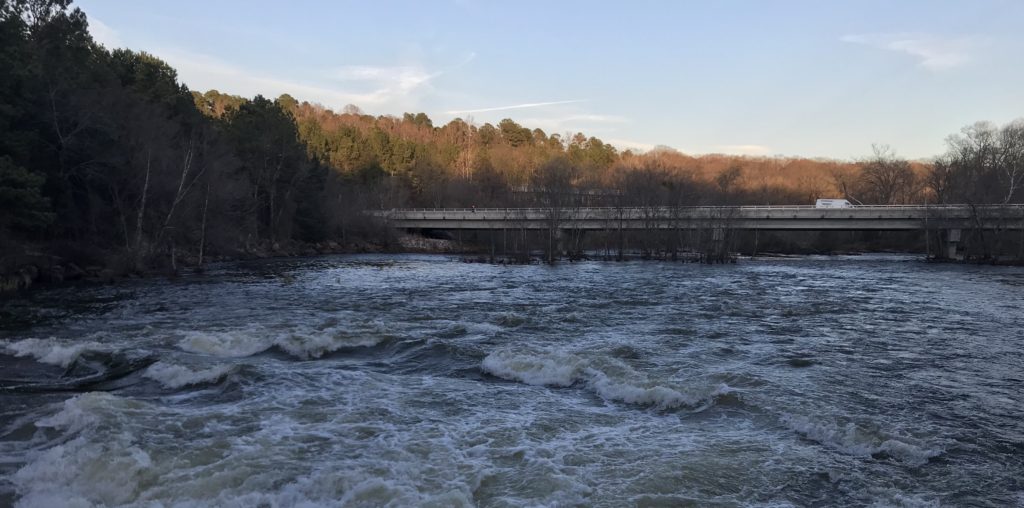
At the lower end of this range, around 1,500cfs the upper wave still has good eddy access and is still relatively tame. The image above shows what the center wave looks like at 1,500cfs. The wave sort of splits into three different zones at this point. The river right section of the wave has sort of a crashing wave feel as the shoulder of the wave curls aggressively toward the center of the wave allowing for effortless clean spins to surfer’s left. The center of the wave turns into more of a wave hole that can munchy. When you jump on the wave the current is going to pull you out to this section and if you don’t carve left you will shoot right of the end of the wave. The third section that will start to form is on the far river left hand side of the wave. There is a little sweet spot where a tall glassy wave forms that, when caught just right, can be surfed effortlessly for minutes on end. It is pretty tough to catch though.
The image below shows the upper wave at 1,600cfs. As you can see, the wave that curls toward the center of the wave from the surfers left shoulder is much more retentive and has a thicker foam pile. Overall the wave is more retentive at 1,600cfs than it is at 1,500cfs.
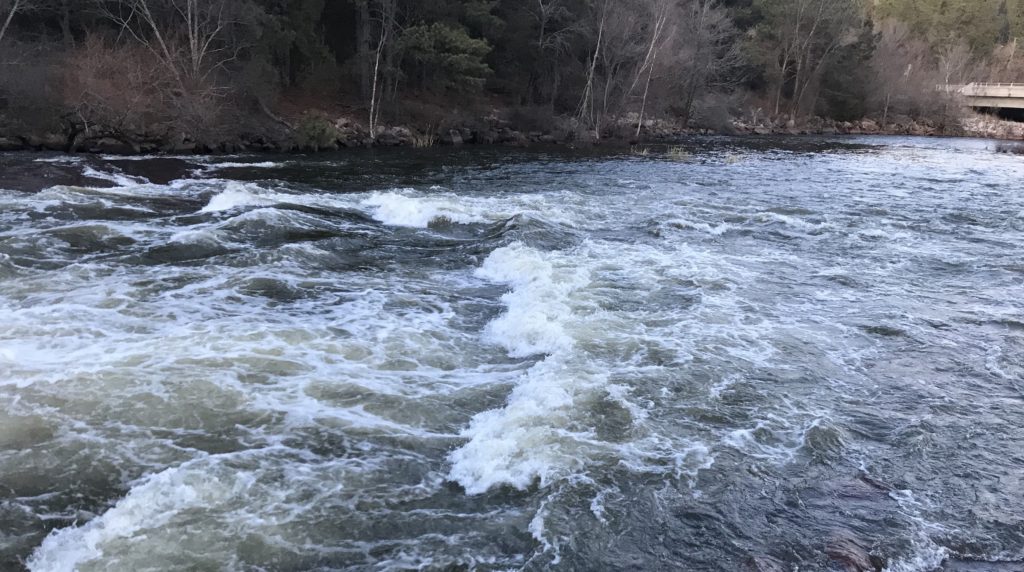
As the level increases all of the features mentioned above become more pronounced, with the exception of the river right hand shoulder. As the level increases the shoulder becomes less retentive and it takes more concentration to spin in the center of the wave. The foam pile gets massive and extremely retentive. At about 2,000cfs to 2,400cfs the eddy service to the center wave becomes nonexistent. The only way to catch the wave above 2,200cfs is to seal launch off the rocks above the wave and catch it on the fly.
As the water rises the downstream features become more and more fun. There is a pretty big ledge hole that begins to form on the river left hand channel that can be kind of intimidating for beginner paddlers. It is also very retentive so unless you have a solid boof I recommend getting over to the far river left side of the channel to avoid the hole.
Neuse River Whitewater Kayaking Between 2,700cfs and 4,500cfs
Once the Neuse River in Raleigh, NC reaches about 2,700cfs the upper wave gets very big but also becomes a pain in the rear end to catch. The water surges so much you will get tossed around like a rag doll until you fall off. Then you’ll have to carry your boat back up to the top and seal launch back into the wave again. This is fun for a couple of rides but carrying the kayak to the top gets old.
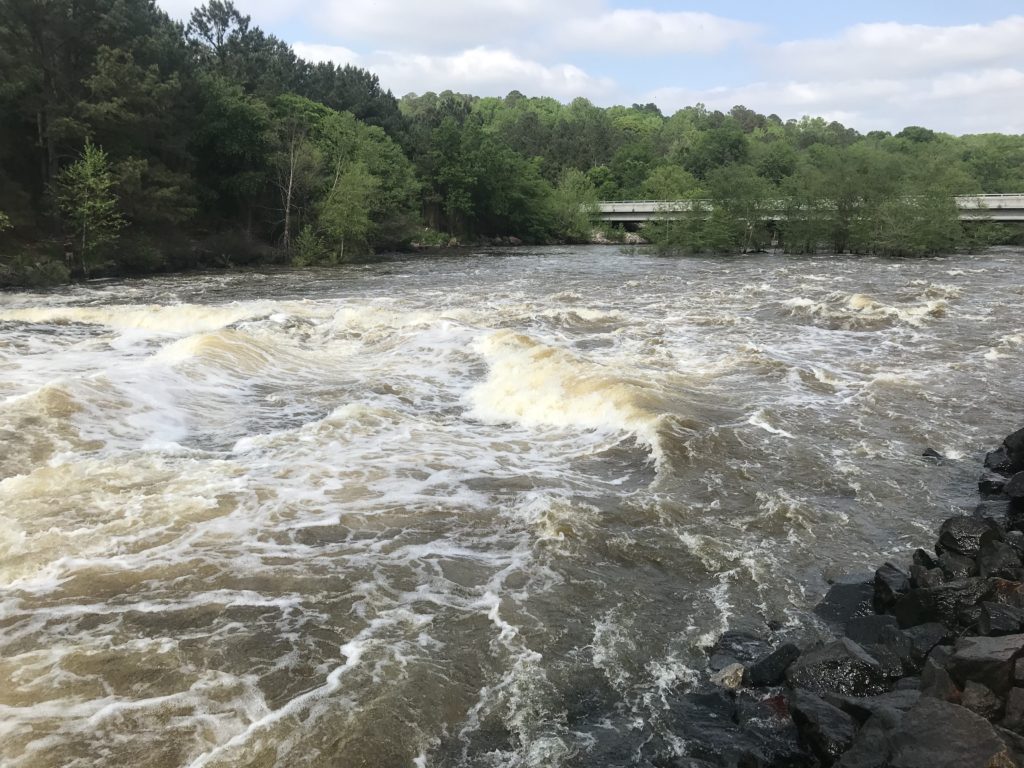
Luckily, between 2,700cfs and 3,200cfs is my personal favorite level to paddle the stretch of river below the main wave. At this level there are a couple of play spots that are some of the best in the Raleigh/ Durham area. You may not be able to do loops, cartwheels, or phoenix monkeys, but you can surf to your hearts desire and even spin and throw blunts (the trick). The first wave you need to check out on the Neuse River between 2,700cfs and 3,200cfs is located right upstream of the second set of pilings from the river right hand bank. This glassy wave is steep enough to be very retentive and wide enough to carve back and forth.
Another wave you need to check out between 2,700cfs and 3,200cfs is in the river left channel after the big ledge hole. Immediately below the ledge hole there is a large eddy on the river right hand side. This eddy services a nice reactionary wave I like to call the butter wave. This name comes from the fact that this wave is extremely smooth to surf. The wave has a slight break at the top of it and is just retentive enough to land blunts and get spins around. This wave is also in very deep water so it makes a great place to practice combat rolls, do stern squirts and wave wheels. The only real down side to this wave is that if you are slow to roll when you flip you have to put in some effort to make it back into the eddy before you float down into the next pool.
In the river right hand channel that runs directly beside the greenway trail there are some decent ledges that are great for practicing boof strokes and catching micro eddys. The first ledge has a couple of eddys that are fun to catch and hop back across the holes. There is even a little eddyline pocket that is great for spins. Here is what the first ledge in the river right channel on the Neuse River looks like at 2,700cfs:
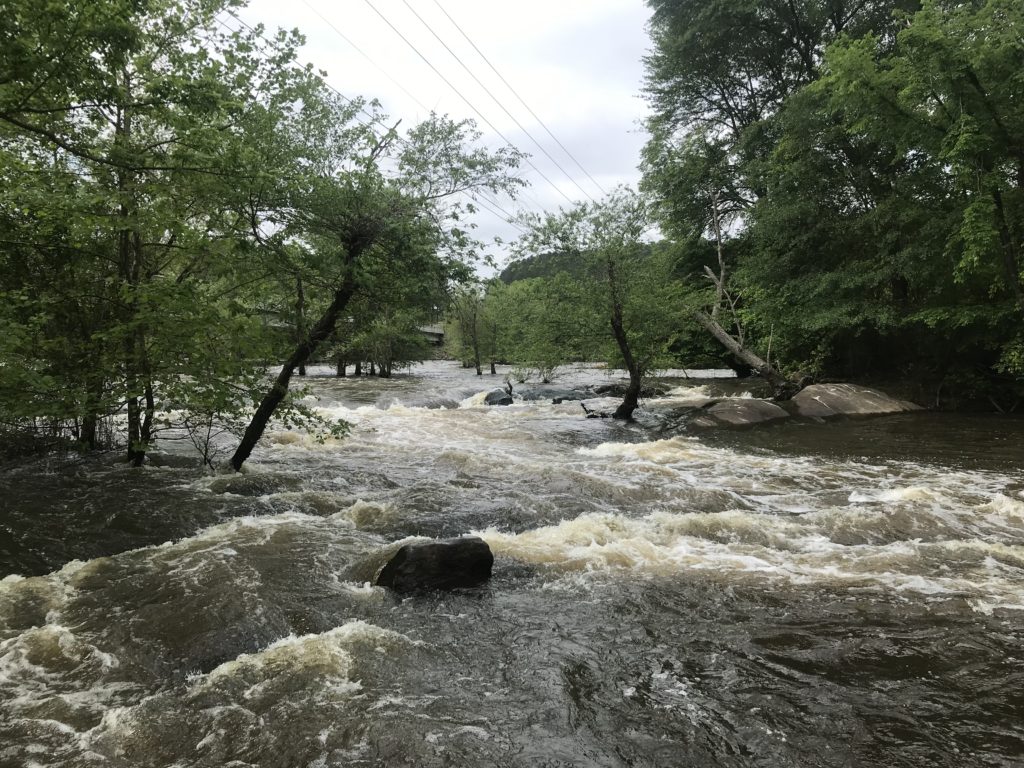
Below this ledge there is a nearly river wide slab of granite that creates a very retentive hole that is great for practicing side surfing and clean spins. As the water level increases this hole becomes pretty munchy but is a great place to practice as consequences of a swim are low. Here is what this ledge looks like at 2,700cfs:
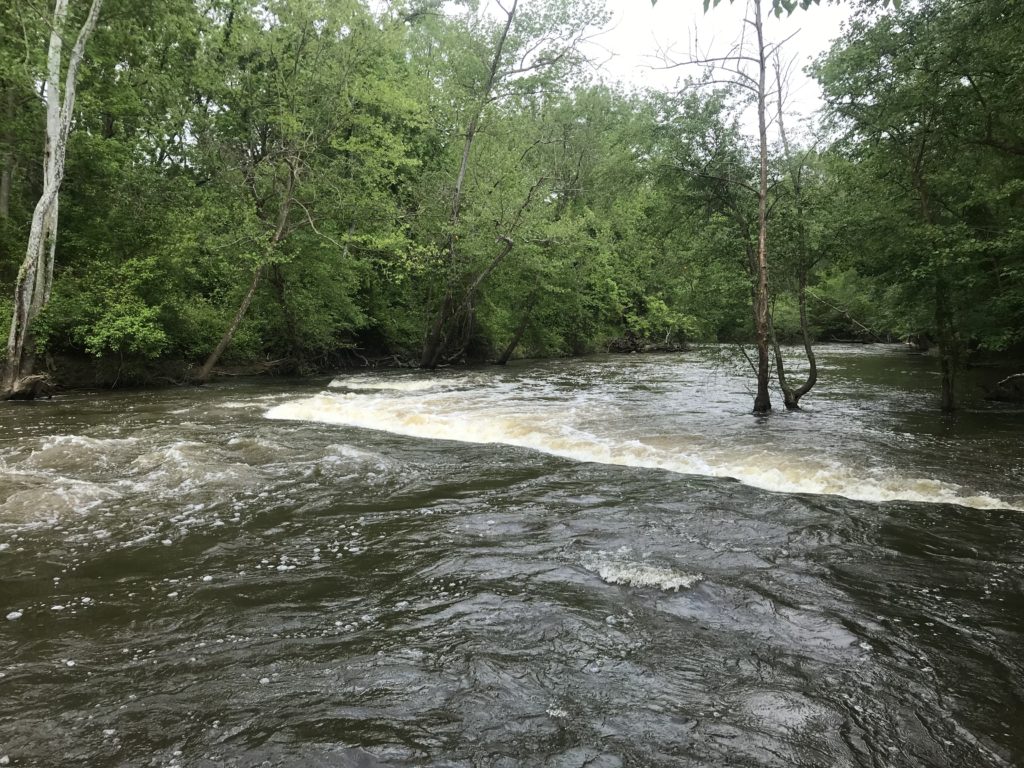
Above 3,500cfs the features in the river left hand channel start to wash out. At this point the only real whitewater left is the giant waves directly below the spillway, and the ledges in the river right hand channel. As the water gets higher these ledges get deep enough to do some low angle cartwheels and spins.
Once the Neuse gets over 4,000cfs there is not much worth paddling playboat wise, other than the giant wave at the top, and a little shoulder wave below the first island that is not even that retentive. Typically if the Neuse is releasing at over 4,000cfs there are other local options, like the Haw, that are running that would be more worth your while.
